International Journal of Intelligent Systems and Applications @ijisa
Статьи журнала - International Journal of Intelligent Systems and Applications
Все статьи: 1214
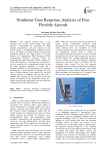
Nonlinear Gust Response Analysis of Free Flexible Aircraft
Статья научная
Gust response analysis plays a very important role in large aircraft design. This paper presents a methodology for calculating the flight dynamic characteristics and gust response of free flexible aircraft. A multidisciplinary coupled numerical tool is developed to simulate detailed aircraft models undergoing arbitrary free flight motion in the time domain, by Computational Fluid Dynamics (CFD), Computational Structure Dynamics (CSD) and Computational Flight Mechanics (CFM) coupling. To achieve this objective, a structured, time-accurate flow-solver is coupled with a computational module solving the flight mechanics equations of motion and a structural mechanics code determining the structural deformations. A novel method to determine the trim state of flexible aircraft is also stated. First, the field velocity approach is validated, after the trim state is attained, gust responses for the one-minus-cosine gust profile are analyzed for the longitudinal motion of a slender-wing aircraft configuration with and without the consideration of structural deformation.
Бесплатно
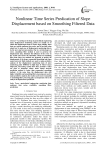
Nonlinear Time Series Predication of Slope Displacement based on Smoothing Filtered Data
Статья научная
According to the slope in geotechnical engineering, many displacement monitoring points are usually set to obtain the displacement data to ensure slope stability, these data are typical nonlinear time series, and it has high value about how to make use of displacement monitoring data to do the next step forecast analysis. Due to a certain degree of error, smoothing filter method is used to pretreat the displacement data, eliminate the influence of the error on the results and ensure the rationality. Based on smoothing filter data, these two methods are proposed to predict the displacement of the slope: exponential smoothing and chaos neural network. Both methods are used to make predictive analysis of the displacement monitoring data of outer monitoring point TP/BM27 in high slope of Three Gorges Ship-Lock, forecasting results show that: predictive values are close to measured values, chaos neural network prediction method is better than exponential smoothing method. At the same time, the displacement data with higher reliability and smoothing filter processing are used to make predictive analysis, the results can be more reasonable, so smoothing filter processing plays an important role in the analysis of displacement prediction.
Бесплатно
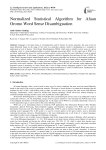
Normalized Statistical Algorithm for Afaan Oromo Word Sense Disambiguation
Статья научная
Language is the main means of communication used by human. In various situations, the same word can mean differently based on the usage of the word in a particular sentence which is challenging for a computer to understand as level of human. Word Sense Disambiguation (WSD), which aims to identify correct sense of a given ambiguity word, is a long-standing problem in natural language processing (NLP). As the major aim of WSD is to accurately understand the sense of a word in particular context, can be used for the correct labeling of words in natural language applications. In this paper, I propose a normalized statistical algorithm that performs the task of WSD for Afaan Oromo language despite morphological analysis The propose algorithm has the power to discriminate ambiguous word’s sense without windows size consideration, without predefined rule and without utilize annotated dataset for training which minimize a challenge of under resource languages. The proposed system tested on 249 sentences with precision, recall, and F-measure. The overall effectiveness of the system is 80.76% in F-measure, which implies that the proposed system is promising on Afaan Oromo that is one of under resource languages spoken in East Africa. The algorithm can be extended for semantic text similarity without modification or with a bit modification. Furthermore, the forwarded direction can improve the performance of the proposed algorithm.
Бесплатно
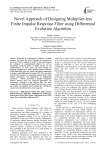
Статья научная
Reduction of computational complexity of digital hardware has drawn the special attention of researchers in recent past. Proper emphasis is needed in this regard towards the settlement of computationally efficient as well as functionally competent design of digital systems. In this communication, we have made one novel attempt for designing multiplier-free Finite duration Impulse Response (FIR) digital filter using one robust evolutionary optimization technique, called Differential Evolution (DE). The search has been directed through two sequentially opposite paths which include quantization and optimization as fundamental operations. Besides performing a detailed comparative analysis between these two proposed approaches; the performance evaluation of the designed filter with other existing discrete coefficient FIR models has also been carried out. Finally, the optimum search method for realizing the required set of specifications has been suggested.
Бесплатно
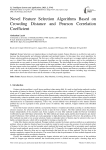
Novel Feature Selection Algorithms Based on Crowding Distance and Pearson Correlation Coefficient
Статья научная
Feature Selection is an important phase in classification models. Feature Selection is an effective task used to decrease the dimensionality and eliminate redundant and unrelated features. In this paper, three novel algorithms for feature selection problem are proposed. The first one is a filter method, the second one is a wrapper method, and the last one is a hybrid filter method. Both the proposed algorithms use the crowding distance used in the multiobjective optimization as a new metric to assess the importance of the features. The idea behind the use of the crowding distance is that the less crowded features have great impacts on the target attribute (class), and the crowded features have generally the same impact on the class attribute. To enhance the crowded distance, a combination with other metrics will give good results. In this work, the hybrid method combines between the crowding distance and Pearson correlation coefficient to well order the importance of features. Experiments on well-known benchmark datasets including large microarray datasets have shown the effectiveness and the robustness of the proposed algorithms.
Бесплатно
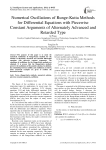
Статья научная
The purpose of this paper is to study the numerical oscillations of Runge-Kutta methods for the solution of alternately advanced and retarded differential equations with piecewise constant arguments. The conditions of oscillations for the Runge-Kutta methods are obtained. It is proven that the Runge-Kutta methods preserve the oscillations of the analytic solution. In addition, the relationship between stability and oscillations are shown. Some numerical examples are given to confirm the theoretical results.
Бесплатно
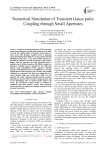
Numerical Simulation of Transient Gauss pulse Coupling through Small Apertures
Статья научная
Transient electromagnetic pulse (EMP) can easily couple into equipments through small apertures in its shells. To study the coupling effects of transient Gauss pulse to a cubic cavity with openings, coupling course is simulated using sub-gridding finite difference in time domain (FDTD) algorithm in this paper. A new grid partition approach is provided to simulate each kind of apertures with complex shapes. With this approach, the whole calculation space is modeled, and six kinds of aperture with different shapes are simulated. Coupling course is simulate in the whole time domain using sub-gridding FDTD approach. Selecting apertures with dimension of several millimeters to research, coupled electric field waveform, power density and coupling coefficient are calculated. The affect on coupling effects by varied incident angle and varied pulse width are also analyzed. The main conclusion includes interior resonance phenomenon, increase effect around rectangle aperture and several distributing rules of coupled electric field in the cavity. The correctness of these results is validated by comparing with other scholars’ results. These numerical results can help us to understand coupling mechanism of the transient Gauss pulse.
Бесплатно
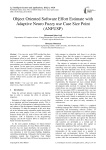
Object Oriented Software Effort Estimate with Adaptive Neuro Fuzzy use Case Size Point (ANFUSP)
Статья научная
Use case size point (USP) method has been proposed to estimate object oriented software development effort in early phase of software project and used in a lot of software organizations. Intuitively, USP is measured by counting the number of actors, preconditions, post conditions, scenarios included in use case models. In this paper have presented a Adaptive fuzzy Neural Network model to estimate the effort of object oriented software using Use Case size Point approach. In our proposed system adaptive neural network fuzzy use case size point has less error and system worked more accurate and appropriative than prior methods.
Бесплатно
Object Tracking System Using Approximate Median Filter, Kalman Filter and Dynamic Template Matching
Статья научная
In this work, we dealt with the tracking of single object in a sequence of frames either from a live camera or a previously saved video. A moving object is detected frame-by-frame with high accuracy and efficiency using Median approximation technique. As soon as the object has been detected, the same is tracked by kalman filter estimation technique along with a more accurate Template Matching algorithm. The templates are dynamically generated for this purpose. This guarantees any change in object pose which does not be hindered from tracking procedure. The system is capable of handling entry and exit of an object. Such a tracking scheme is cost effective and it can be used as an automated video conferencing system and also has application as a surveillance tool. Several trials of the tracking show that the approach is correct and extremely fast, and it's a more robust performance throughout the experiments.
Бесплатно
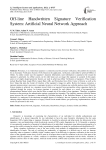
Off-line Handwritten Signature Verification System: Artificial Neural Network Approach
Статья научная
Nowadays, it is evident that signature is commonly used for personal verification, this justifies the necessity for an Automatic Verification System (AVS). Based on the application, verification could either be achieved Offline or Online. An online system uses the signature’s dynamic information; such information is captured at the instant the signature is generated. An offline system, on the other hand, uses an image (the signature is scanned). In this paper, some set of simple shaped geometric features are used in achieving offline Verification of signatures. These features include Baseline Slant Angle (BSA), Aspect Ratio (AR), and Normalized Area (NA), Center of Gravity as well as the line’s Slope that joins the Center of Gravities of the signature’s image two splits. Before the features extraction, a signature preprocessing is necessary to segregate its parts as well as to eliminate any available spurious noise. Primarily, System training is achieved via a signature record which was acquired from personalities whose signatures had to be validated through the system. An average signature is acquired for each subject as a result of incorporating the aforementioned features which were derived from a sample set of the subject’s true signatures. Therefore, a signature functions as the prototype for authentication against a requested test signature. The similarity measure within the feature space between the two signatures is determined by Euclidian distance. If the Euclidian distance is lower than a set threshold (i.e. analogous to the minimum acceptable degree of similarity), the test signature is certified as that of the claiming subject otherwise detected as a forgery. Details on the stated features, pre-processing, implementation, and the results are presented in this work.
Бесплатно
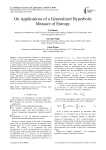
On Applications of a Generalized Hyperbolic Measure of Entropy
Статья научная
After generalization of Shannon’s entropy measure by Renyi in 1961, many generalized versions of Shannon measure were proposed by different authors. Shannon measure can be obtained from these generalized measures asymptotically. A natural question arises in the parametric generalization of Shannon’s entropy measure. What is the role of the parameter(s) from application point of view? In the present communication, super additivity and fast scalability of generalized hyperbolic measure [Bhatia and Singh, 2013] of probabilistic entropy as compared to some classical measures of entropy has been shown. Application of a generalized hyperbolic measure of probabilistic entropy in certain situations has been discussed. Also, application of generalized hyperbolic measure of fuzzy entropy in multi attribute decision making have been presented where the parameter affects the preference order.
Бесплатно
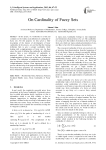
Статья научная
In this article, we would like to revisit and comment on the widely used definition of cardinality of fuzzy sets. For this purpose we have given a brief description of the history of development of fuzzy cardinality. In the process, we can find that the existing definition fails to give a proper cardinality while dealing with complementation of fuzzy sets. So there arises the need of defining the cardinality in a different manner. Here a new definition of cardinality is proposed which is rooted in the definition of complementation of fuzzy sets on the basis of reference function. This definition of cardinality will inevitably play an important role in any problem area that involves complementation. Further, some important results are proven with the help of the proposed definition and it is found that these properties are somewhat analogus to those obtained with the help of the existing definition.
Бесплатно
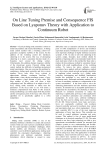
Статья научная
Classical sliding mode controller is robust to model uncertainties and external disturbances. A sliding mode control method with a switching control low guarantees asymptotic stability of the system, but the addition of the switching control law introduces chattering in to the system. One way of attenuating chattering is to insert a saturation function inside of a boundary layer around the sliding surface. Unfortunately, this addition disrupts Lyapunov stability of the closed-loop system. Classical sliding mode control method has difficulty in handling unstructured model uncertainties. One can overcome this problem by combining a sliding mode controller and fuzzy system together. Fuzzy rules allow fuzzy systems to approximate arbitrary continuous functions. To approximate a time-varying nonlinear system, a fuzzy system requires a large amount of fuzzy rules. This large number of fuzzy rules will cause a high computation load. The addition of an adaptive law to a fuzzy sliding mode controller to online tune the parameters of the fuzzy rules in use will ensure a moderate computational load. Refer to this research; tuning methodology can online adjust both the premise and the consequence parts of the fuzzy rules. Since this algorithm for is specifically applied to a robot manipulator.
Бесплатно
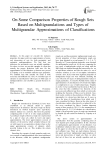
Статья научная
In this paper we consider the inclusion properties for upper and lower approximation of union and intersection of sets for both pessimistic and optimistic multigranulations. We find that two inclusions for pessimistic cases are actually equalities. For other six cases we provide examples to show that actually the proper inclusions hold true. On the approximation of classifications a theorem was proved in Tripathy et al to establish sufficient type properties. We establish here that actually the result is both necessary and sufficient one. Also, we consider types of elements in classifications with respect to both types of multigranulations and establish a general theorem on them.
Бесплатно
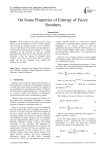
On Some Properties of Entropy of Fuzzy Numbers
Статья научная
Here at first we are going to give a brief history of the development of fuzzy entropy. Finally, new measures for entropy of fuzzy sets in continuous cases are introduced. In this article, our main purpose is to show that the entropy of fuzzy number is very much dependent on the selection of intervals. Another important thing which can be observed from the cases discussed is that the entropy of triangular fuzzy numbers is the same for the same choice of interval length and for non triangular fuzzy number this property does not hold.
Бесплатно

On Some Results Based on Geometrical Representation of Fuzzy Sets
Статья научная
The main purpose of this article is to highlight the fact that there are some drawbacks in the existing definition of complementation of fuzzy sets and hence the geometrical representation of fuzzy sets on the basis of such definition which itself is defective would have no meaning. As a result the theorems or formulas which were rooted in the geometrical representation would become unacceptable and it is realized that in most cases of practical significance it is desirable to consider an additional requirement in defining fuzzy complement. It is important to mention here the fact that all these existing properties are being seen through the application of complementation of fuzzy sets which is rooted in the reference function. The current definition of complementation would infact remove those drawbacks and cosequently produce the results which seems to be logical.
Бесплатно
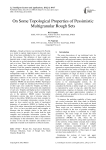
On Some Topological Properties of Pessimistic Multigranular Rough Sets
Статья научная
Rough set theory was introduced by Pawlak as a model to capture impreciseness in data and since then it has been established to be a very efficient tool for this purpose. The definition of basic rough sets depends upon a single equivalence relation defined on the universe or several equivalence relations taken one each at a time. There have been several extensions to the basic rough sets introduced since then in the literature. From the granular computing point of view, research in classical rough set theory is done by taking a single granulation. It has been extended to multigranular rough set (MGRS) model, where the set approximations are defined by taking multiple equivalence relations on the universe simultaneously. Multigranular rough sets are of two types; namely optimistic MGRS and pessimistic MGRS. Topological properties of rough sets introduced by Pawlak in terms of their types were studied by Tripathy and Mitra to find the types of the union, intersection and complement of such sets. Tripathy and Raghavan have extended the topological properties of basic single granular rough sets to the optimistic MGRS context. Incomplete information systems take care of missing values for items in data tables. MGRS has also been extended to such type of incomplete information systems. In this paper we have carried out the study of topological properties of pessimistic MGRS by finding out the types of the union, intersection and complement of such sets. Also, we have provided proofs and examples to illustrate that the multiple entries in the table can actually occur in practice. Our results hold for both complete and incomplete information systems. The multiple entries in the tables occur due to impreciseness and ambiguity in the information. This is very common in many of the real life situations and needed to be addressed to handle such situations in efficient manner.
Бесплатно
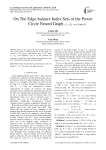
On The Edge-balance Index Sets of the Power Circle Nested Graph C_(7^m)×P_(m_7) (m≡2(mod3))
Статья научная
Based on the equal-cycle nested graph, the power-cycle nested graph is brought forward. In this paper, we research on the largest edge-balance index of the graph C_(7^m)×P_(m_7) (m≡2(mod3))(m≥5) by the methods and techniques of graph theory and combinatorial mathematics, and solve formula proof and graphic tectonic methods.
Бесплатно
On the Performance of Classification Techniques with Pixel Removal Applied to Digit Recognition
Статья научная
The successive loss of the outermost pixel values or frames in the digital representation of handwritten digits is postulated to have an increasing impact on the degree of accuracy of categorizations of these digits. This removal of frames is referred to as trimming. The first few frames do not contain significant amounts of information and the impact on accuracy should be negligible. As more frames are trimmed, the impact becomes more significant on the ability of each classification model to correctly identify digits. This study focuses on the effects of the trimming of frames of pixels, on the ability of the Recursive Partitioning and Classification Trees method, the Naive Bayes method, the k-Nearest Neighbor method and the Support Vector Machine method in the categorization of handwritten digits. The results from the application of the k-Nearest Neighbour and Recursive Partitioning and Classification Trees methods exemplified the white noise effect in the trimming of the first few frames whilst the Naive Bayes and the Support Vector Machine did not. With respect to time all models saw a relative decrease in time from the initial dataset. The k-Nearest Neighbour method had the greatest decreases whilst the Support Vector Machine had significantly fluctuating times.
Бесплатно
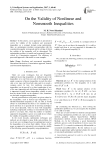
On the Validity of Nonlinear and Nonsmooth Inequalities
Статья научная
In this article, a new approach is presented to survey the validity of the nonlinear and nonsmooth inequalities on a compact domain using optimization. Here, an optimization problem corresponding with the considered inequality is proposed and by solving of which, the validity of the inequality will be determined. The optimization problem, in smooth and nonsmooth forms, is solved by a linearization approach. The efficiency of presented approach is illustrated in some examples.
Бесплатно

